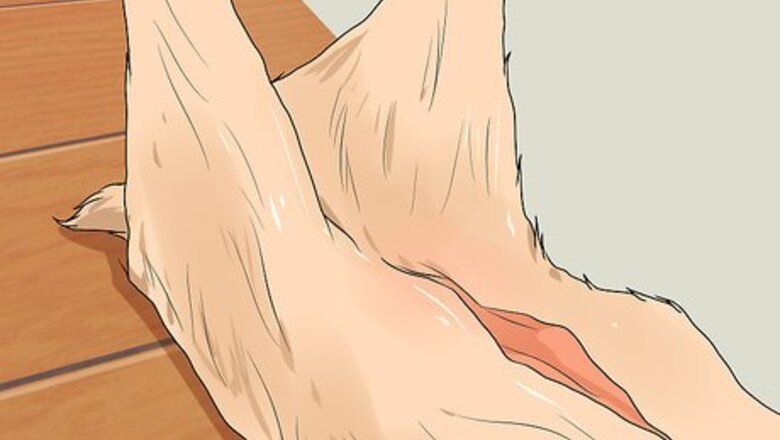
views
Hanging the Deer
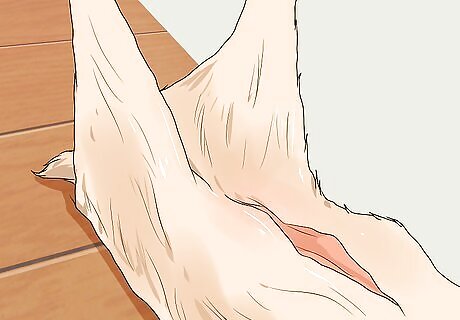
Field dress the deer. To prevent contamination of the meat as you skin it, you should first field dress the deer. Make an incision along the chest of the deer, starting just below the brisket midway down the chest, and stopping just above the deer's hip bone. Remove the internal organs of the deer and dispose of them, being careful not to puncture or cut through them at any point. When field dressing and skinning a deer, use a hunting knife that is as sharp as possible to make the process easier.

Open the skin on the front leg joints. With the deer on its back, use one hand to push one of the front legs backward to reveal a joint in the middle of the leg. Place your knife right on this joint and, using medium pressure, cut around the circumference of the leg to slice through the skin. This should reveal the joint slightly. Repeat for the other front leg. Always do shallow cuts to start with when skinning a deer. If you cut too deeply, you may slice through meat or tendons unnecessarily. Start shallow and begin to cut deeper once you feel more comfortable with the process.
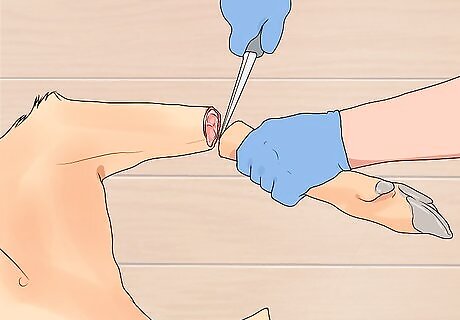
Saw through the joint to remove the front legs. Hold a bone saw or sharp knife over the cut in the skin of the front legs, right at the center of the knee joint. Begin sawing through the joint to sever the leg in two. Do this for both front legs and dispose of them. There’s very little meat or fur on the legs, so removing them first will keep them out of your way without wasting anything of importance. If you prefer, you can make a cut down the leg towards the hoof to remove the skin, keeping the leg attached. If you don’t have a saw or don’t want to risk dulling your knife, you can use a sharp downward motion on the bottom half of the leg to snap it at the joint. You will need to hold the upper leg firm as you do this, but otherwise, it should break cleanly and easily. You may need to cut through a small amount of skin on the other side to fully separate it.
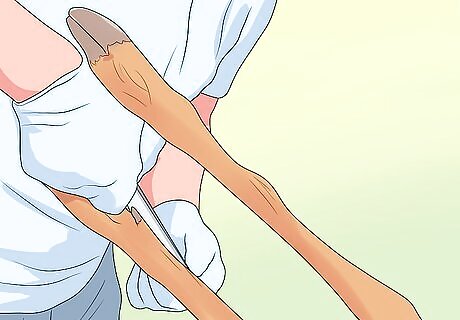
Cut down the inside of the rear legs. Find the knee joint on one of the rear legs and place the point of your knife roughly 3 inches (7.6 cm) above it, towards the hoof and on the inside of the leg. Apply a firm pressure to the skin with your knife and begin cutting in a straight line down toward the hip-bone of the deer. Keep cutting until you reach the base of the cut made when field dressing the deer. Repeat on the other leg. The two cuts along the legs and the one down the chest of the deer should meet near the hip-bone to form a “Y” shape.
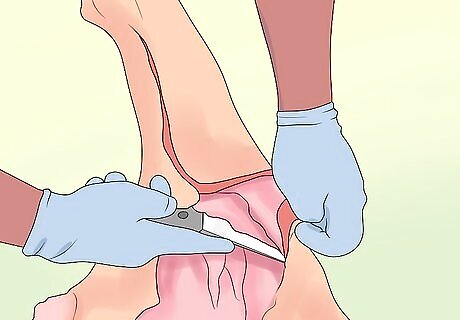
Peel the skin back around the legs to reveal the joints. Firmly grasp a corner of skin on the outside of the cuts between the field dressing and one of the leg incisions. Begin pulling the skin backward, revealing one side of the hip area on the deer. You should slowly peel the skin away from one of the rear legs. Repeat with the other leg until both leg joints are skinned and revealed. You should be able to pull the skin off with just your hands. If you find any points where the skin isn’t easily separating from the meat, use the sharp edge of your knife the slice the two apart and keep working.
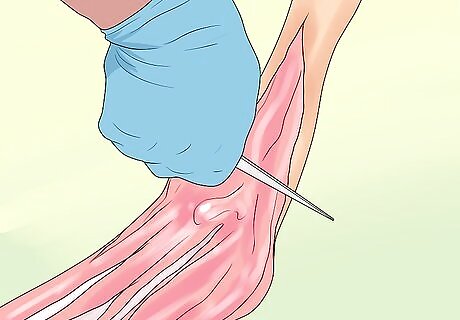
Cut through the middle of the joint to snap the back legs. Use the tip of your knife to locate the center of the joint in the middle of the deer’s back leg. This will be the softest and easiest part to cut. Begin sawing through the joint until the foreleg splits from the rest of the deer. As with the front legs, you should be able to snap the rear legs easily. Alternately, you can use a saw to cut through the joint just as easily. Be careful to avoid cutting through the tendon on the rear of the deer’s legs. The space between the tendon and the bone will be used to hook the gambrel and hoist the deer up later on. When cutting through the joint, try and leave the skin on the underside of the legs connected to the rest of the deer. If the legs stay connected with a small amount of skin, you can use the leg bones as a grip to make pulling the skin off much easier.
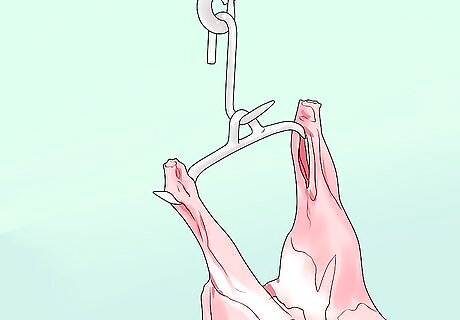
Hook a gambrel under the tendons of each leg. A gambrel is a wide piece of metal with hooks on each end used to hold animals up as they are processed. Holding the gambrel between the deer’s legs, look for the space between the bone and the tendon near where you cut the legs. Hook each side of the gambrel through one of these spaces and pull on it to make sure it holds firmly. If you don’t have a gambrel, you can use a long and sturdy tree branch with a rope in the middle instead. Otherwise, you could thread a length of rope through each tendon and tie it off tightly to hold the deer. However, these may not be as easy to work with or as strong as a metal gambrel.
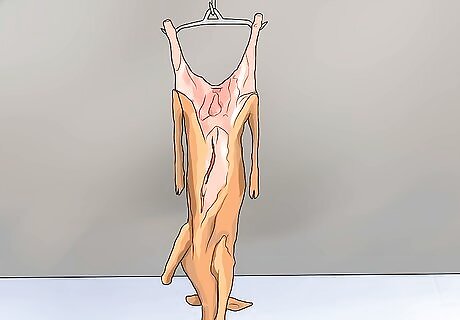
Hoist the deer off the ground. Throw a long piece of rope over a sturdy looking tree branch at least 2.5 metres (8.2 ft) off the ground. Tie one end to the middle of the gambrel and pull on the other end of the rope to begin hoisting the deer upward. Once the deer is hanging entirely, tie the rope off to a nearby tree to hold it in place. This will be much easier with the help of a friend or two. Get someone to help lift the deer up and hold it in place while you tie the rope off. Instead of a tree branch, you can use the bucket of a tractor to hold the deer. Tie the deer to the bucket while it is lowered and raise it to lift the deer up easily.
Removing the Pelt
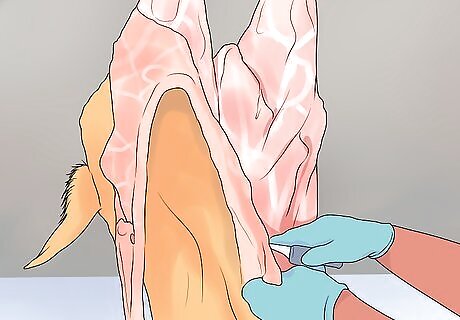
Pull back the skin around the chest cavity. Start near the base of the legs and begin peeling the skin backward and outward away from the chest cavity of the deer. If you cannot easily pull the skin away from the deer, use the sharp edge of a knife to cut it away from the flesh and keep pulling. Continue working down the chest until the skin folds open like a book. As you begin pulling away skin, you will reveal a silverish membrane lining between the skin and the muscle. Try to separate the skin from this, leaving the membrane attached to the muscle, as this will make the skinning process much easier.
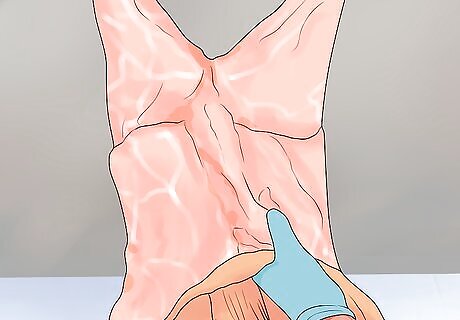
Peel the skin back toward the tail. Firmly grasp the flap of skin at the bottom of the chest cavity, between the two rear legs, and begin pulling it upward and backward over the hipbone of the deer. Fold it behind the deer and peel it down until the skin begins coming away from the tail and reveals the tailbone.
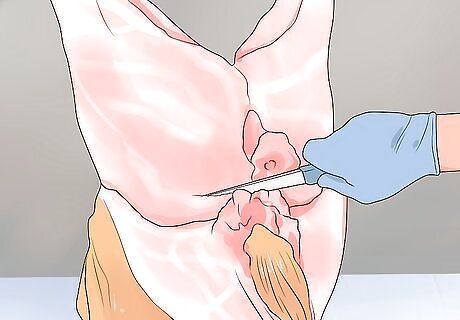
Cut through the tailbone. Pull the skin back as close to the tailbone as you can, revealing the softest part of the tailbone right at the base of the tail. Use the sharp point of your knife to cut through this part of the tailbone and separate it from the rest of the body. You may need to trim a few extra pieces of skin around the tailbone to fully remove it. Cut away as little as you can to maintain the state of the hide.
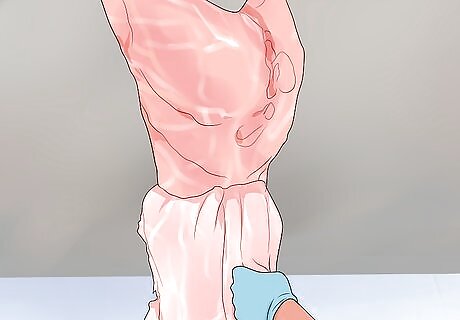
Continue peeling the skin down toward the head. Use one hand to firmly hold the loose skin away from the deer carcass. Keep your other hand in a loose fist and push it down between the skin and the meat to separate the two. Pull the skin away as you do so, and repeat around the body of the deer until you reach the front legs. As you work, make sure to keep one hand for holding the skin and one hand for working close to the meat. This will prevent any hair from transferring from the skin to the meat and dirtying it.
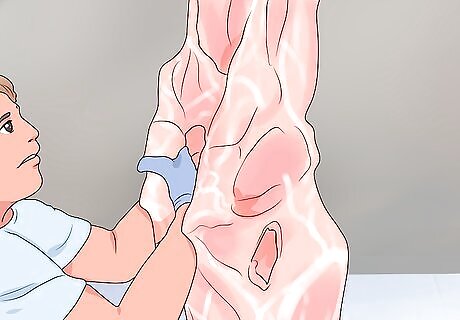
Strip the skin over the front legs. Evenly begin pulling the skin over the two front legs, rolling from the body down toward the end of the legs. This should mimic the way you would roll down and remove a sock. If you can, raise the carcass up higher at this point to give you more leverage when pulling downward. At this point, it may be useful to hold the rear legs of the deer and use these as a grip to pull the skin downward. This will give you something more solid to hold and may give you more leverage.
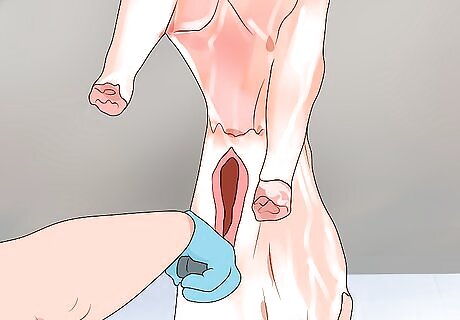
Cut the skin open to reveal the head and neck. The head should now be mostly covered by the removed skin that is hanging loosely over the deer. Start at the top of the incision from your field dressing and cut upwards along the loose skin towards the base of the neck. This will allow you to part the loose skin and gain easy access to the deer's head. If you want to preserve the head for mounting, you will need to keep both the head and the neck in a good condition. Cut the skin to the base of the neck so the skin around the neck remains intact.
Removing the Head
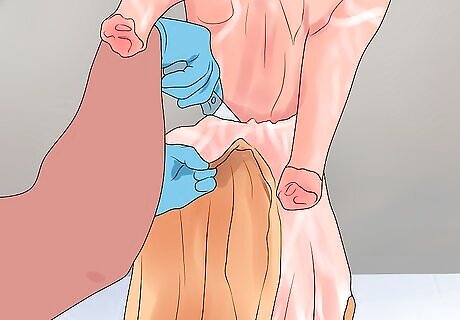
Strip the skin from the neck. Following the same cut you have made through the center of the skin, make another cut down the deer's neck towards the base of the head. Pull down on the skin until it is completely separated from the neck. At this point, the deer should be entirely skinned apart from the head. Don’t worry about any loose hairs on the meat, as these can be washed away once the skinning process is done.
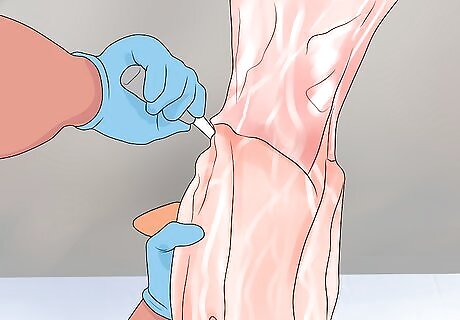
Cut through the flesh around the top of the neck. Place your knife on one side of the neck, at the point closest to the head where the meat is revealed. Begin cutting through the flesh around the neck, rotating your knife around the spine until you have a complete cut through to the bone.
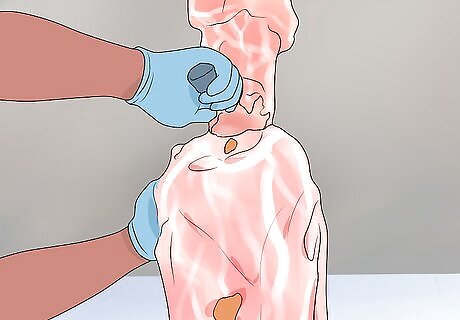
Saw through the neck to remove the head. Use a very sharp knife or a bone saw to cut through the bone that holds the head to the rest of the body. When it is fully detached, lower it to the ground and disconnect it from the rest of the skin.
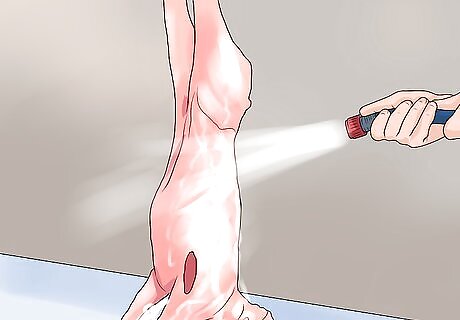
Remove the pelt and wash the carcass. With the head removed, the pelt should now be entirely detached from the carcass. Pull the pelt away from the deer, either saving it for tanning or disposing of it safely. With the deer still hanging, use a garden hose or another source of clean water to wash the carcass of any stray hairs or remaining blood. If you don't have anywhere to safely dispose of the skin, dig a hole in the ground to put the skin in and cover it up with dirt. This will stop other animals from getting to it and will prevent strong odors as it decomposes.














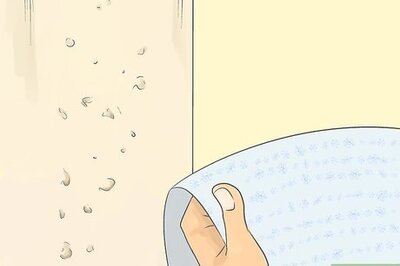





Comments
0 comment